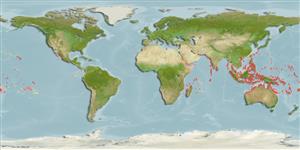Common names from other countries
分類 / Names
共通名の | 類義語 | Catalog of Fishes(部類, 種) | ITIS | CoL | WoRMS | Cloffa
>
Ovalentaria/misc (Various families in series Ovalentaria) >
Pomacentridae (Damselfishes) > Pomacentrinae
Etymology: Chrysiptera: Greek, chrysos = golden + Greek, pteron = fin, wing (Ref. 45335).
More on authors: Quoy & Gaimard.
Environment: milieu / climate zone / depth range / distribution range
生態学
海 関連する礁; 移住性ではない; 深さの範囲 0 - 5 m (Ref. 7247). Tropical; 30°N - 23°S
Indo-Pacific: East Africa to the Marshall and Gilbert islands and Samoa, north to the Ryukyu Islands, south to Australia.
サイズ / 重さ / 年齢
Maturity: Lm ? range ? - ? cm
Max length : 12.5 cm TL オス/雌雄の選別がない; (Ref. 48600)
背面の脊椎 (合計): 13; 背鰭 (合計): 12-14; 肛門の骨 2; 臀鰭: 13 - 14. Bluish or purplish spots at the posterior base of the dorsal fin. Juveniles with large ocellus that reduces with size and lacks completely in adults. The white band in young reduces to a small white saddle in large adults (Ref. 48636). Body depth 2.2-2.5 in SL (Ref. 90102).
Adults occur in protected inner reef flats and shallow lagoons and channels, over rubble and rocky outcrops. Feed primarily on filamentous algae (Ref. 7247). Oviparous, distinct pairing during breeding (Ref. 205). Eggs are demersal and adhere to the substrate (Ref. 205). Males guard and aerate the eggs (Ref. 205). Diurnal species (Ref. 54980; 113699).
Life cycle and mating behavior
成熟 | 繁殖 | 放精 | 卵 | 生産力 | 幼生
Oviparous, distinct pairing during breeding (Ref. 205). Eggs are deposited inside empty shells or under stones or shells (Ref. 36479). Males guard and aerate the eggs (Ref. 205).
Allen, G.R., 1991. Damselfishes of the world. Mergus Publishers, Melle, Germany. 271 p. (Ref. 7247)
IUCNのレッドリストの状況は (Ref. 130435)
Warning: mysqli::__construct(): (HY000/1040): Too many connections in /var/www/html/includes/func_getlabel.php on line 46
Can't connect to MySQL database (fbapp). Errorcode: Too many connections
